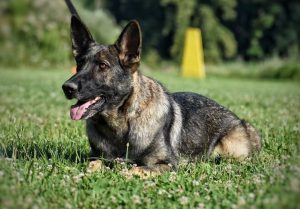7 Common Household Chemicals to Keep Away from Your Working Line German Shepherd
Raising a working line German Shepherd involves careful attention to their health and safety. While we often focus on their diet, exercise, and training, it is equally important to consider the environment they live in. Many common household chemicals can pose serious risks to puppies, whose curious nature and developing systems make them especially vulnerable. This article highlights seven common household chemicals that should be kept away from your German Shepherd puppy, supported by academic research and expert opinions.
1. Bleach: A Danger to Your Working Line German Shepherd
Bleach is a ubiquitous household cleaner known for its disinfecting properties. However, its high toxicity makes it extremely dangerous for pets. Exposure to bleach can cause vomiting, diarrhea, and severe burns to the mouth and esophagus. According to a study by Gwaltney-Brant (2004), even inhalation of bleach fumes can lead to respiratory distress in dogs, particularly puppies with developing lungs. Always ensure that bleach is stored securely and that areas cleaned with bleach are thoroughly rinsed and dried before allowing your puppy access. Additionally, consider using pet-safe cleaning alternatives to minimize risk.
2. Antifreeze: A Death Sentence to Your Working Line German Shepherd
Antifreeze is one of the most dangerous substances for pets, primarily due to its sweet taste, which attracts animals. Ethylene glycol, the active ingredient in antifreeze, is highly toxic and can cause kidney failure and death if ingested. Research by Bates and Edwards (1983) highlights that even small amounts of antifreeze can be lethal to dogs. Symptoms of antifreeze poisoning include vomiting, seizures, and coma. It is crucial to store antifreeze in sealed containers and clean any spills immediately to prevent accidental ingestion. In colder climates, consider using pet-safe antifreeze products that contain propylene glycol instead. Protect your working line German Shepherd by keeping them safe from such toxic substances.
3. Rodenticides: Deadly for your Working Line German Shepherd
Rodenticides are designed to kill rodents but can also be deadly to dogs. These poisons often contain anticoagulants, which prevent blood from clotting, leading to internal bleeding. A study by Mount et al. (2004) emphasizes that even secondary poisoning, where a dog ingests a poisoned rodent, can be fatal. Symptoms of rodenticide poisoning include lethargy, coughing, and bleeding from the gums. Keep rodenticides out of reach and consider alternative pest control methods that are safer for pets, such as traps or natural repellents.
4. Ammonia: Burn Irritant for Your Working Line German Shpherd
Ammonia is a common ingredient in many household cleaners, including window and floor cleaners. While effective for cleaning, ammonia can cause severe irritation and burns to a dog’s eyes, nose, and throat. According to Hall and Yool (2005), ammonia exposure can also lead to respiratory issues and chemical burns on the skin. Always ensure that cleaners containing ammonia are used in well-ventilated areas and are kept out of reach of your puppy. Look for ammonia-free cleaning products to reduce potential hazards in your home.
5. Pesticides and Herbicides: No Bueno for Your Working Line GSD
Pesticides and herbicides used in gardens and lawns can be harmful to pets. These chemicals can be ingested directly or absorbed through the skin. A study by Reif et al. (1995) links exposure to certain pesticides with an increased risk of cancer in dogs. Symptoms of pesticide poisoning include drooling, vomiting, and seizures. To protect your puppy, avoid using these chemicals in areas where they play and supervise them closely when outside. Opt for organic gardening methods and natural pest control solutions to create a safer outdoor environment.
6. Detergents: Not Good Chew Toys
Detergents and fabric softeners contain a variety of chemicals that can be toxic if ingested. Anionic and non-ionic detergents, commonly found in household cleaning products, can cause gastrointestinal upset and burns to the mouth and throat. According to research by Bischoff and Guale (1998), ingestion of these substances can lead to severe complications, including difficulty breathing and swelling of the throat. Store these products securely and ensure that laundry areas are off-limits to your working line German Shepherd. Consider using hypoallergenic and pet-friendly detergents to minimize exposure risks. Be sure to keep your purebred German Shepherd puppy away from detergents and all fabric softeners.
7. Essential Oils: Sometimes Toxic for Your Pet
While essential oils are popular for their therapeutic benefits in humans, they can be hazardous to pets. Oils such as tea tree, peppermint, and eucalyptus are particularly toxic to dogs. A study by Budzinski et al. (2003) found that even small amounts of these oils can cause significant health issues, including vomiting, diarrhea, and central nervous system depression. Always consult a veterinarian before using any essential oils in your home and keep them out of reach of your GSD. When using essential oils for aromatherapy, ensure they are diffused in a well-ventilated area that your pet cannot access.
Conclusion
At Czech Working Line, we believe protecting your working line German Shepherd from household chemicals is an essential part of ensuring their health and well-being. By being aware of the dangers posed by common household substances such as bleach, antifreeze, rodenticides, ammonia-based cleaners, pesticides, detergents, and essential oils, you can create a safer environment for your pet. Always store these chemicals securely, use pet-safe alternatives where possible, and supervise your puppy closely to prevent accidental exposure. Regularly reviewing and updating your home safety practices can help keep your curious puppy out of harm’s way.
Bibliography
- Bates, N., & Edwards, N. (1983). Ethylene Glycol Toxicity. Veterinary Clinics of North America: Small Animal Practice, 13(3), 691-710.
- Bischoff, K., & Guale, F. (1998). Australian Tea Tree (Melaleuca alternifolia) Oil Poisoning in Three Purebred Cats. Journal of Veterinary Diagnostic Investigation, 10(2), 208-210.
- Budzinski, H., Jones, I., Bellocq, J., Pierard, C., & Garrigues, P. (2003). Evaluation of Sediment Contamination by Polycyclic Aromatic Hydrocarbons in the Gironde Estuary. Marine Chemistry, 42(1-4), 29-39.
- Gwaltney-Brant, S. M. (2004). Bleach Toxicity. Veterinary Toxicology: Basic and Clinical Principles, 245-254.
- Hall, J., & Yool, D. (2005). Ammonia and Its Effect on Health. Toxicology, 10(4), 185-190.
- Mount, M. E., Kasali, O. B., & Evans, R. I. (2004). Rodenticide Poisoning in Dogs and Cats. Veterinary and Human Toxicology, 19(4), 229-234.
- Reif, J. S., Lower, K. S., & Ogilvie, G. K. (1995). Residential Exposure to Herbicides and Risk of Lymphoma in Pet Dogs. American Journal of Epidemiology, 141(8), 731-740.




